2010 Sea-Doo WAKE Pro 215 Review
Tow enthusiasts will welcome new electronic throttle
Ask any skier, wakeboarder or wakeskater and chances are they’ll tell you PWC drivers are just plain bad at towing. It’s not (always) the driver’s fault. A lot of the problem lies with the craft itself, particularly how hard it is to hold the throttle at a steady speed, or pull a rider up smoothly without jerking his or her arms off.
The market for a boat that solves these problems may be small, but Sea-Doo’s going after it.
Man vs. Machine
The new WAKE Pro 215 changes Sea-Doo’s Wake line substantially. It borrows the S3 hull design introduced on last year’s suspension models, sports a newly tooled, fixed deck design, and features the nifty “intelligent brake and reverse” functions introduced in 2009.
The biggest change for skiers and riders, however, will be the move to electronic throttle. Now, rather than attempt to hold a steady speed at 22 mph, drivers will be able to let the ECU do the work for them. Speed control eliminates the surges and slowdowns that plague human pilots, and allow the driver to simply squeeze the throttle fully and hang on for the ride. I’ve tested it numerous times and found it to work quite well, even when I steer the boat through a turn, a moment when many boat speed controls either race or lose their steam. You can even turn back for a downed rider, then resume your desired speed once you pull them out of the water again.
Basic speed control, however, is so 2009. Sea-Doo’s take on the concept also now includes five separate acceleration profiles for the driver to choose. Pull kids on a tube and you can choose a slow acceleration, guaranteed not to yank the kiddies for a loop. Turn your attention to an adult on a slalom ski and you can give them the strong surge they require to get up and out of the water without excessive dragging. Sea–Doo dubs it “ski mode,” and it allows a driver to give their towee the same predictable pull every time. I liked it a lot, with only one exception. At the high end, the acceleration comes on so suddenly it gave my rider quite a yank. I would feather the throttle more at the very beginning to avoid that scenario, before following a similar acceleration curve. Sea-Doo was still fine-tuning these profiles before production, so the situation may improve.
Under iControl
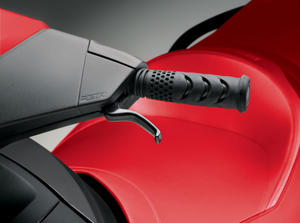 Sea-Doo’s iControl allows the driver to put the brakes on.
Sea-Doo’s iControl allows the driver to put the brakes on.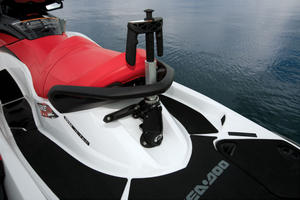 The retractable ski pylon keeps the towrope out of the water and the jet wash.
The retractable ski pylon keeps the towrope out of the water and the jet wash.Machine also benefits man in braking and control situations. Like other boats with Sea-Doo’s iControl, the Wake Pro features “intelligent brake and reverse.” Need to stop suddenly and, rather than cringe and coast, you can pull a lever on the left handle grip. The computer stops the thrust for a split-second, drops the reverse bucket, and then carefully reapplies the power. Forward motion is dramatically slowed, and stopping distance is reduced by as much as fifty-percent.
More practical around the dock is that the system allows you to start in neutral, essentially holding position rather than surging forward. Squeeze the combination brake/reverses lever and the craft backs away; squeeze the throttle and it moves forward. It’s a great, practical solution.
Additional tow features include a gunwale-mounted board rack to allow occupants to carry wakeboards and wakeskates without cluttering the footwells. A three-position retractable ski pylon also positions the towrope higher off the water. No, it doesn’t exactly give you big air like a wake boat’s pylon, but it at least gets the rope out of the jet wash. Grab handles are attached to provide more security for a rear-facing spotter.
Further pulling refinement is offered by the high-performance variable trim system. It allows the driver to pre-set positions and then access them quickly on the water. I kept the bow low for acceleration, and then moved it higher to generate more wake size for the boarder I towed during my test. Wide-angle convex mirrors also gave me a better view of the rider in my wake.
Off The Wake
When not skiing, boarding, or skating, the WAKE Pro resembles the model it in effect is, the RXT 215 (the previous GTX 215 now gets suspension for 2010). Under the seat is all the power of the supercharged 215hp Rotax 4-TEC, contained within the S3 hull design that carves precise turns on the water, and handles the best in rough water of any Sea-Doo in my recent memory. I reached 63.1 mph on a somewhat choppy day in Florida’s intracoastal, and noted strong acceleration out of the hole.
That means the WAKE Pro also gets standard Sea-Doo amenities like off-throttle steering, and dual safety lanyards that double as speed limiters and theft-prevention keys. A reboarding ladder eases getting back aboard the craft, and a watertight, removable storage bin hauls additional gear. Just watch what you bring. In this new hull and deck style, the capacity is down to 13.7 gallons.
I’d suggest you be a towsports enthusiast to buy it, but if you do it’s kind of like getting two boats in one — a normal Sea-Doo, and a ski-and-wake ready towboat.
At least you won’t have to hear any more comments about bad driving…
| Sea-Doo WAKE Pro 215 Specs | |
| Length | 139.0 inches |
| Beam | 48.0 inches |
| Dry Weight | 855 lbs |
| Engine | Three-cylinder EFI, Supercharged/Intercooled |
| Displacement | 1,494 cc |
| Bore and Stroke | 100mm x 63.4mm |
| Compression Ratio | 8.4:1 |
| Rated Horsepower | 215 |
| Fuel Capacity | 15.9 gal. |
| Combined Stowage Capacity | 13.7 gal. |
| Colors | Deep Black/Viper Red |
| Price | $13,499 |
Related Reading
2009 Sea-Doo Wake 155/Wake Pro 215 Review
2010 Sea-Doo Lineup Preview
All Things Sea-Doo on PersonalWatercraft.com
Get PersonalWatercraft.com in your Inbox!
Like PersonalWatercraft.com on Facebook
Comments
Most Popular

2025 Yamaha JetBlaster PRO 2-Up Review

Remembering the Sea-Doo XP

2024 Kawasaki Jet Ski STX 160X Review

2024 Yamaha GP HO Review

2017 Kawasaki Jet Ski Ultra 310LX Review




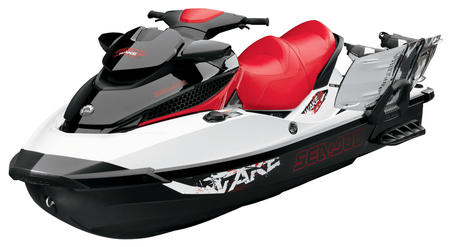
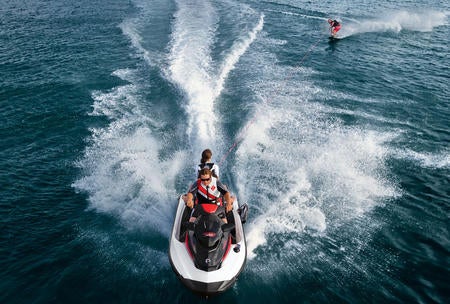
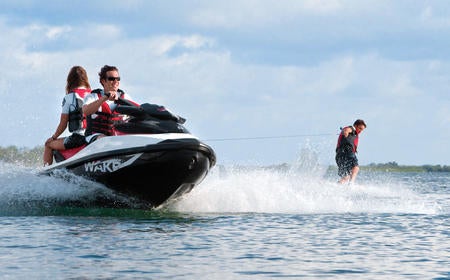







 Your Privacy Choices
Your Privacy Choices